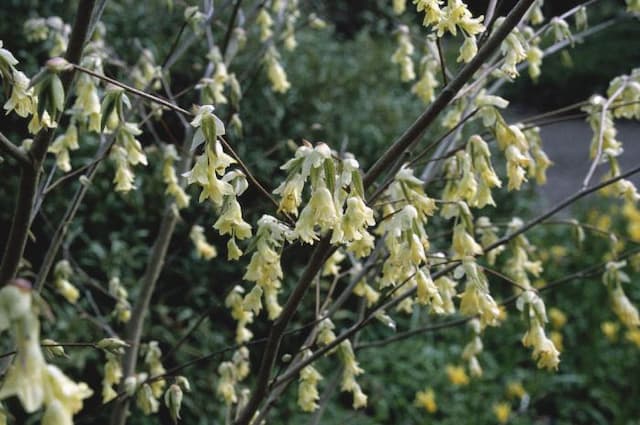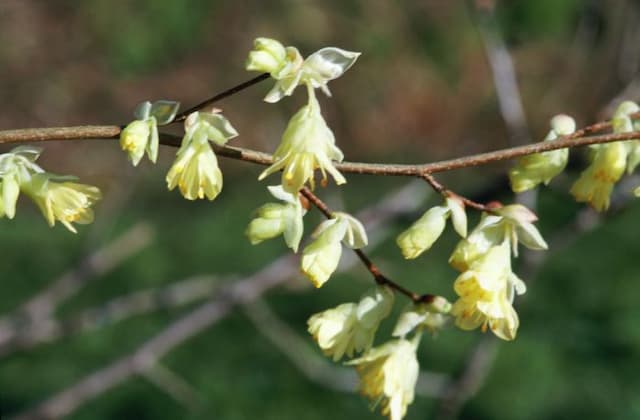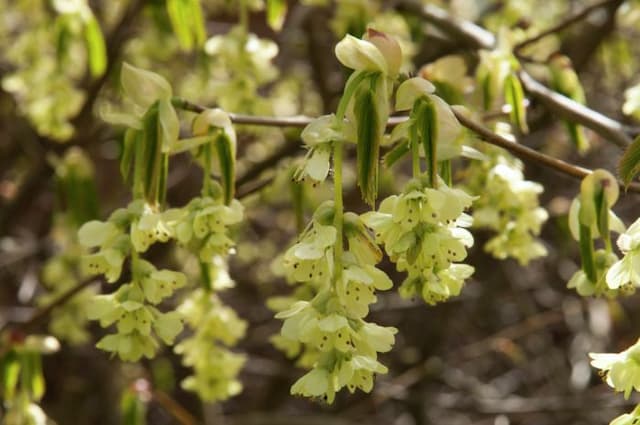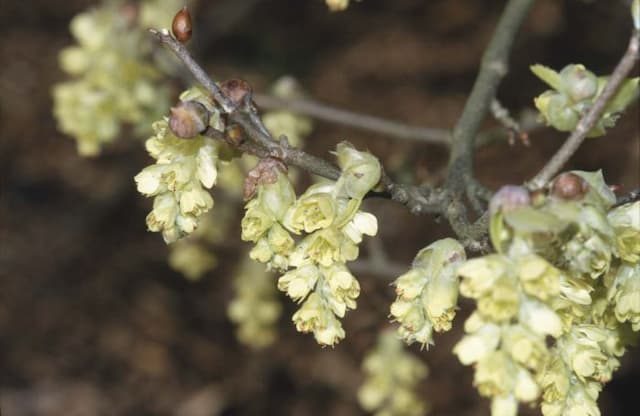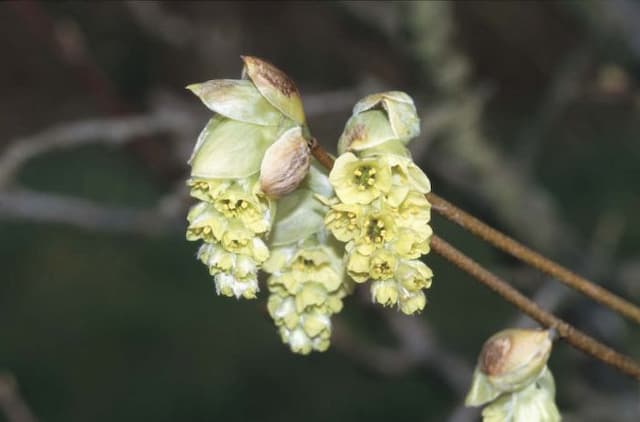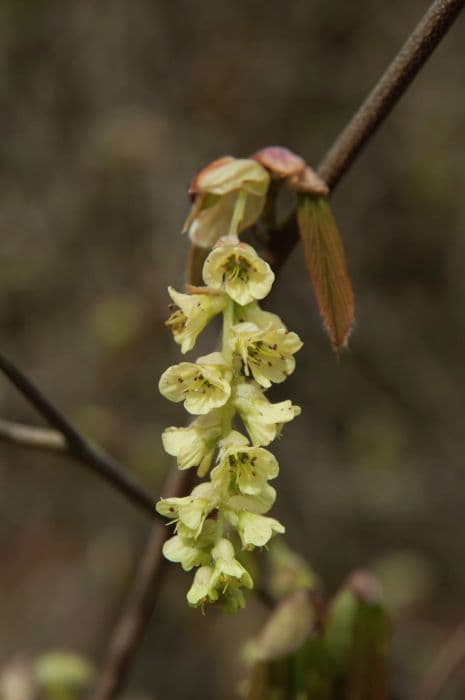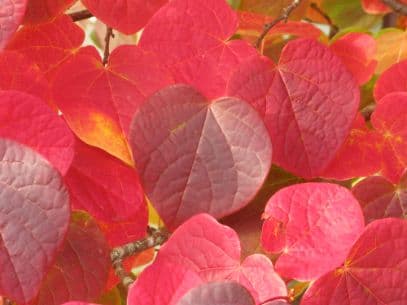Sweetgum Liquidambar styraciflua 'Lane Roberts'
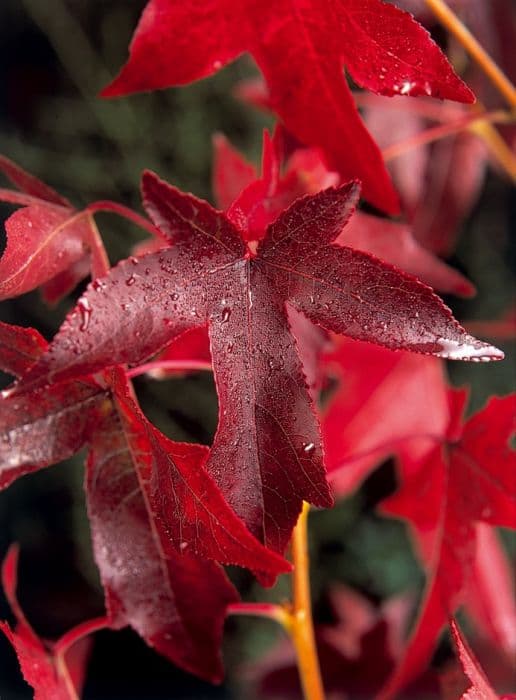
ABOUT
The Liquidambar styraciflua 'Lane Roberts', commonly known as the Sweetgum, is a stunning deciduous tree known for its distinctive appearance and vibrant seasonal colors. The Sweetgum bears star-shaped leaves that have five to seven pointed lobes, creating an elegant and somewhat angular aesthetic. The foliage undergoes a splendid transformation throughout the year, showcasing a broad palette of colors. During spring and summer, the leaves are a lively green, creating a dense and refreshing canopy. As the seasons turn to autumn, the Sweetgum puts on a spectacular display of colors ranging from rich purples to fiery reds, intense oranges, and even subtler yellows, making it a favorite for adding dramatic fall color to landscapes. The bark of the Sweetgum is deeply furrowed, featuring corky ridges that develop with age, adding a rugged texture to the trunk. This contrasts with the smooth, glossy appearance of the young twigs and branches. The Sweetgum also produces unique, spiky fruiting balls that hang from the branches. These seed balls persist through winter, creating visual interest even after the leaves have dropped. Overall, the distinctiveness of the Sweetgum lies in its versatile display of foliage throughout the seasons and its textured bark, which contribute to its popularity as an ornamental tree.
About this plant
 Names
NamesSynonyms
American Sweetgum, Redgum, Sweet Gum, Satin Walnut, Star-Leaved Gum, Alligator Wood, Bilsted.
Common names
Liquidambar styraciflua.
 Toxicity
ToxicityTo humans
The American Sweetgum is generally not considered highly toxic to humans. However, ingesting parts of the plant, particularly the seeds, can cause discomfort. If a person consumes significant quantities, it may lead to gastrointestinal upset, such as nausea or diarrhea. It is always advisable to avoid eating any parts of ornamental plants due to potential adverse effects.
To pets
The American Sweetgum is not considered highly toxic to pets either. Similar to humans, if pets ingest parts of the plant such as the seeds or leaves, they might experience mild gastrointestinal upset. Signs of discomfort may include vomiting or diarrhea. It is still recommended to keep pets from ingesting the plant to avoid any potential issues.
 Characteristics
CharacteristicsLife cycle
Perennials
Foliage type
Deciduous
Color of leaves
Mixed
Height
60-70 feet [18-21 meters]
Spread
40-50 feet [12-15 meters]
Plant type
Tree
Hardiness zones
5-9
Native area
North America
Benefits
 General Benefits
General Benefits- Aesthetic Appeal: Adds vibrant fall color with its deep red to purple foliage, enhancing landscape beauty.
- Shade Provider: Can serve as a natural canopy offering shade in gardens and parks.
- Habitat for Wildlife: Offers shelter and food sources for birds and small mammals.
- Decorative Fruit: Produces distinctive spiky fruit that adds ornamental interest to the plant year-round.
- Longevity: A long-lived tree that, with proper care, can stand for multiple generations.
- Seasonal Interest: Provides year-round interest with changing foliage, flowers, and fruit.
- Soil Stabilization: Its root system can help in preventing soil erosion.
- Versatile Landscaping: Suitable for a variety of landscape designs including urban environments.
- Cultural Significance: Often used in holiday decorations and festivities, particularly in the United States.
 Medical Properties
Medical PropertiesThis plant is not used for medical purposes.
 Air-purifying Qualities
Air-purifying QualitiesThis plant is not specifically known for air purifying qualities.
 Other Uses
Other Uses- Liquidambar styraciflua 'Lane Roberts', commonly known as Sweetgum, can be used as a source of shikimic acid, an essential ingredient for the production of antiviral medications like Tamiflu.
- The hardened sap, known as styrax, can serve as a natural chewing gum or used in the creation of perfumes and incense for its aromatic properties.
- The spiky seed balls can be used in craft projects or as natural holiday decorations when spray-painted and glittered.
- Its fine-grained wood is valued for woodworking and can be turned into furniture, cabinetry, and interior millwork.
- The lumber is also prized for making musical instruments, due to its capacity to create resonant soundboards.
- The extract from Sweetgum trees can be utilized as a flavoring agent in the food industry, especially for sweet-savory dishes.
- Sweetgum is occasionally utilized in agroforestry systems because it contributes positively to nitrogen accumulation in soil.
- Creative gardeners may use Sweetgum branches and twigs to form natural and biodegradable garden supports or trellises for climbing plants.
- The dense canopy of Sweetgum, during its growth, offers a shady environment which can be used to cultivate shade-loving plants beneath it.
- Innovative designers occasionally use the attractive star-shaped leaves for eco-printing on fabric and paper, transferring the pigments and patterns naturally.
Interesting Facts
 Feng Shui
Feng ShuiThe Sweetgum tree is not used in Feng Shui practice.
 Zodiac Sign Compitability
Zodiac Sign CompitabilityThe Sweetgum tree is not used in astrology practice.
 Plant Symbolism
Plant Symbolism- Change and Transformation: The American Sweetgum is renowned for its spectacular fall colors, often seen as a symbol of the changing seasons and the idea that change can be beautiful and natural.
- Protection: In some cultures, the spiky gumballs of this tree are thought to ward off evil spirits, symbolizing protection and defense.
- Longevity: The American Sweetgum can live up to 400 years, making it a symbol of endurance and longevity.
- Healing: Traditionally, the resin from sweetgum trees, called storax, has been used for medicinal purposes, representing healing and the soothing of wounds.
- Flexibility: Despite its hard wood, the American Sweetgum is known for its ability to bend in storms without breaking, symbolizing flexibility and resilience in the face of challenges.
 Water
WaterSweetgum (Liquidambar styraciflua 'Lane Roberts') should be watered deeply, ensuring that water reaches the roots without flooding the area. Initially, water it once a week with approximately 10 gallons during its first growing season to establish a deep, extensive root system. After establishment, reduce the frequency but water thoroughly; during dry spells or in extreme heat, watering may need to increase to once a week. Adjust according to rainfall, with less water needed during wet periods. It’s important to avoid overwatering, as this can lead to root rot.
 Light
LightSweetgum prefers full sun to partial shade for optimal growth. It thrives best in a spot that receives at least six hours of direct sunlight daily. Partial shade is acceptable, particularly in hotter climates where afternoon shade can prevent scorching, but too much shade can lead to sparse foliage and a less robust tree.
 Temperature
TemperatureSweetgum can tolerate a wide range of temperatures, from as low as 20°F to highs above 90°F. However, it grows best in temperatures between 70°F and 85°F. It's important to avoid planting in locations where temperatures drop below 20°F frequently, as extreme cold can damage the tree.
 Pruning
PruningSweetgum should be pruned to maintain shape and remove any damaged or diseased branches. Prune during the dormant season in late winter to early spring before new growth starts. Pruning is typically done once a year, but inspect periodically for any broken branches. Proper pruning also encourages healthier growth and maintains the desired form of the tree.
 Cleaning
CleaningAs needed
 Soil
SoilThe ideal soil mix for the Sweetgum should be rich, moist, and well-draining, with a slightly acidic to neutral pH of 5.5 to 7.0. A blend of loamy soil with compost and leaf mold is suitable to support its growth.
 Repotting
RepottingSweetgum trees generally do not need frequent repotting as they are large trees. They can be planted directly in the ground where they will not require repotting.
 Humidity & Misting
Humidity & MistingSweetgum trees are adaptable to a wide range of humidity conditions and do not require specific humidity levels when grown outdoors.
 Suitable locations
Suitable locationsIndoor
Not suitable for indoor growth due to size.
Outdoor
Plant in sun, moist well-drained soil, space to grow.
Hardiness zone
5-9 USDA.
 Life cycle
Life cycleThe life cycle of the American Sweetgum 'Lane Roberts' begins with germination from seed, typically occurring in the spring as temperatures warm, ideally in a moist, well-drained soil environment. Following germination, the seedling stage involves the development of primary leaves and a root system that will support the plant's rapid growth into a sapling. As it enters the juvenile phase, the sapling will establish a more extensive root system, grow rapidly in height, and develop a fuller canopy with the species' characteristic star-shaped leaves that have deep purple to maroon color in autumn. Reaching maturity after several years, the tree will begin to reproduce, producing spiky fruiting balls that contain seeds, and will continue to do this annually; mature trees are noted for their spectacular fall foliage and may live for over 100 years if conditions are favorable. Throughout its life, the tree will undergo periodic cycles of leaf growth in spring, maturation and energy capture through photosynthesis in summer, and leaf shedding in the fall. The tree eventually enters a phase of senescence, where growth slows, and it may become more susceptible to environmental stresses, diseases, or pests, which can lead to its eventual death.
 Propogation
PropogationPropogation time
Early spring
Liquidambar styraciflua 'Lane Roberts', commonly known as Sweet Gum, is most effectively propagated through seed collection and stratification. Seed collection takes place in autumn after the spiky seed balls have dried and opened, releasing the seeds. For successful germination, the seeds require a cold stratification period which simulates winter conditions. The seeds should be mixed with slightly moist sand and stored in a plastic bag within a refrigerator at a temperature of around 34 to 40 degrees Fahrenheit (1 to 4 degrees Celsius) for 1 to 3 months. After stratification, the seeds are sown in well-draining soil mix, lightly covered, and kept consistently moist until germination occurs in the spring. Seedlings require plenty of light and should be protected from extreme conditions until they are strong enough to be planted out.
